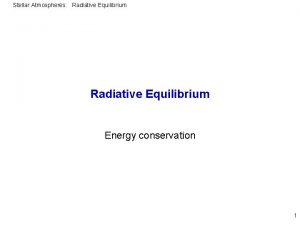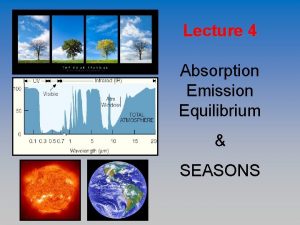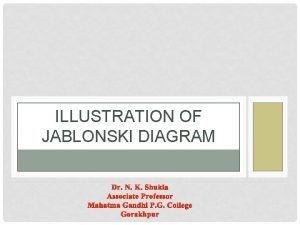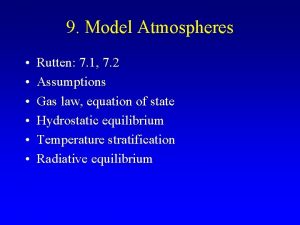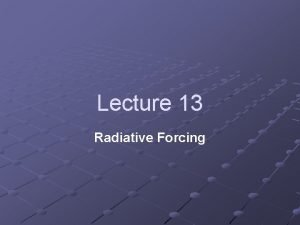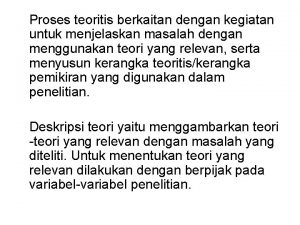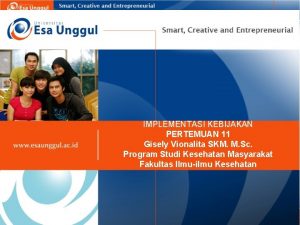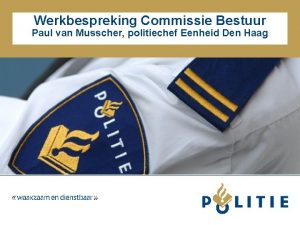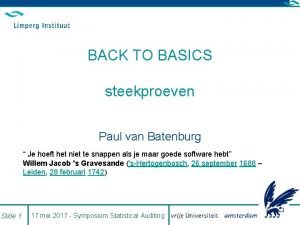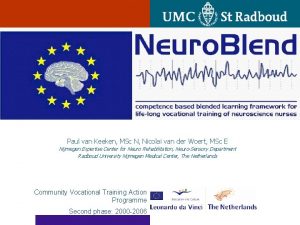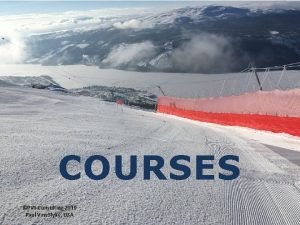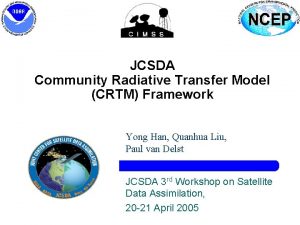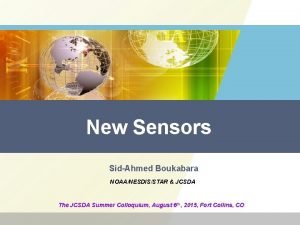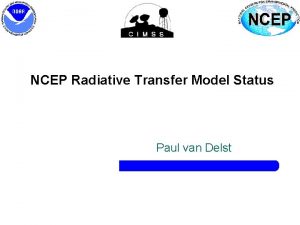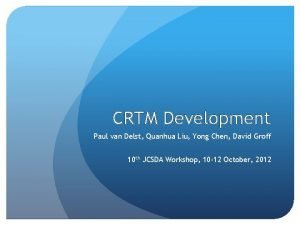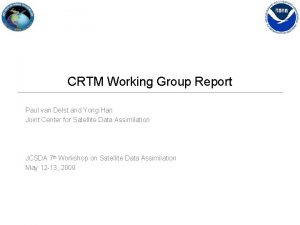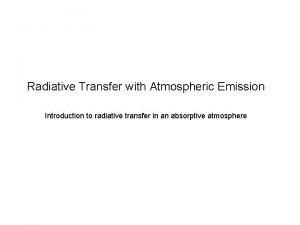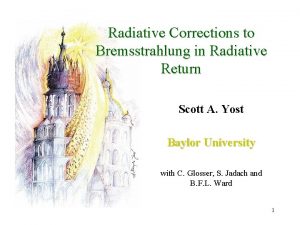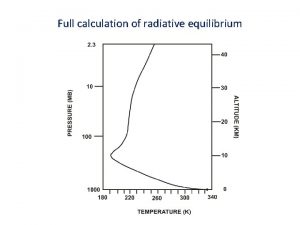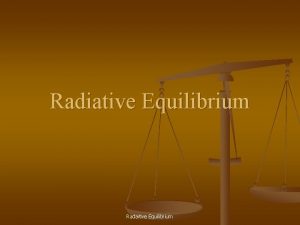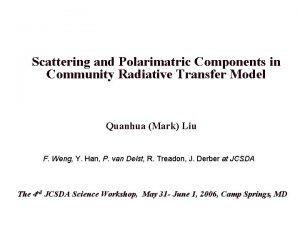JCSDA Community Radiative Transfer Model CRTM Paul van
















- Slides: 16

JCSDA Community Radiative Transfer Model (CRTM) Paul van Delst (CIMSS) Yong Han (NESDIS) Quanhua Liu (QSS) 1 5 th MURI Workshop 7 -9 June 2005 Madison WI

JCSDA Mission l Accelerate and improve the quantitative use of research and operational satellite data in weather and climate prediction models JCSDA Partners NOAA/NWS/NCEP NASA/GSFC Environmental Modeling Center Global Modeling & Assimilation Office NOAA/NESDIS NOAA/OAR Office of Research and Applications Office of Weather and Air Quality US Navy US Air Force Oceanographer of the Navy Naval Research Laboratory (NRL) Air Force Director of Weather Air Force Weather Agency

JCSDA Goals l l Reduce from two years to one year the average time for operational implementation of new satellite technology Increase uses of current satellite data in NWP models Advance the common NWP models and data assimilation infrastructure Assess the impacts of data from advanced satellite sensors on weather and climate predictions

CRTM Contributors l l l l JCSDA/CIMSS. Framework, Cloud. Scatter, IR Sfc. Optics for water, RTSolution for validation (VDISORT) AER Inc; Jean-Luc Moncet’s group. OSS Atm. Absorption. NOAA/ETL; Al Gasiewski’s group. Cloud. Scatter ( W) and RTSolution. NASA/GSFC; Clark Weaver. Aerosol. Scatter (IR). NOAA/NESDIS; Fuzhong Weng’s group. Microwave Sfc. Optics for land, snow, ice. AOS/SSEC/CIMSS/UWisc-Madison; Ralf Bennartz’s group. SOI RTSolution. UCLA; Kuo-Nan Liou’s group. -4 stream RTSolution.

CRTM Schematic

What is the CRTM Framework? l l At the simplest level, it’s a collection of structure definitions, interface definitions, and stub routines. There are User and Developer interfaces, as well as Shared Data interfaces and I/O. Why do this? l l The radiative transfer problem is split into various components (e. g. gaseous absorption, scattering etc) to facilitate independent development. Want to minimise or eliminate potential software conflicts and redundancies. Components developed by different groups can “simply” be dropped into the framework. Faster implementation of new science/algorithms. http: //cimss. ssec. wisc. edu/~paulv/CRTM

Atm. Absorption (1) l Two methodologies – – OPTRAN. Polychromatic (two versions). Adjoint Jacobians. OSS. Monochromatic. Analytic Jacobians. OPTRAN Total channel resolution transmittance OSS Channel radiances are obtained from a weighted sum of monochromatic radiances for a set of predefined nodes, Predict band transmittance for each absorbing gas from absorption coefficient, , predicted from regression fits The monochromatic Rn are obtained from the OSS monochromatic optical depth profiles for the selected node frequencies. Nodes are selected and weights calculated for a channel to satisfy a specified accuracy (e. g. 0. 05 K). Select the regression coefficients, cijk, for each gas that minimises transmittance errors. Higher accuracy more nodes longer computation times.

Atm. Absorption (2) Computation and Memory Efficiency Time needed to process 48 profiles with 7 observation angles Instrument OPTRAN-V 7 Compact. OPTRAN OSS Adjoint AIRS 22 m 36 s 35 m 12 s 3 m 10 s HIRS 13 s 17 s 9 s OPTRAN-V 7 Compact. OPTRAN OSS Double precision Single precision AIRS 66 5 97 HIRS 0. 5 0. 04 4 Memory resource required (Megabytes) Instrument

Cloud. Scatter (1) l NESDIS/ORA lookup table (Liu et al, 2005). – – – l Infrared (Intensity only) – – l Spherical particles for liquid water and ice cloud (Simmer, 1994) Non-spherical ice cloud (Liou and Yang, 1995; Macke et al, 1997; Baum et al, 2001) Microwave (including polarisation) – l Mass extinction coefficient Single scatter albedo Asymmetry factor Legendre phase coefficients and delta-truncation factors for 2 -, 4 -, 6 -, 8 -, and 16 -streams Analytic phase functions (HG and Rayleigh) Spherical particles for rain drops and ice cloud (Simmer, 1994) The number of streams is determined using Mie size parameter, 2 reff/

Cloud. Scatter (2) l l ETL library is microwave only, fixed stream (8) Mie spherical scattering model Five hydrometeor phases, exponential size distributions Phase functions – – l l Currently, Henyey-Greenstein phase function matrix. Being extended to incorporate full Mie scattering phase functions via an exact Mie library. Currently, no polarisation capability. Scattering matrix Jacobians are analytical.

Aerosol. Scatter l l Currently only handles aerosol absorption. Aerosol scattering is planned. Seven aerosol types – – – l l Dust Sea salt Dry and wet organic carbon Dry and wet black carbon Sulfates Multiple size distribution modes. Uses same scattering structure definition as Cloud. Scatter routines

Sfc. Optics l Microwave – – Land (Weng et al, 2001); Snow and sea ice (Yan and Weng, 2003) Ocean l l l Infrared – Land l l l – Measurement database for 24 surface types in visible and infrared (NPOESS Net heat Flux ATBD, 2001) Regression methods Retrieval methods Ocean l l l Wind vector dependent (Liu and Weng, 2003) Wind speed dependent (English, 1998; FASTEM-3) IRSSE (van Delst, 2003). Based on Wu-Smith (1997) model. Nick Nalli (NESDIS/ORA) also working on sea surface emissivity and reflectivity model. New surface optical models are also being developed by other groups (Land data assimilation folks)

RTSolution (1) l SOI, Successive Order of Interaction (UWisc-Madison) – l Truncated doubling technique for layer transmission, reflection and source functions. Successive order of scattering (SOS) used to integrate emission and scattering events from surface and atmosphere. IR and W. (Heidinger et al, 2005) Vector delta 4 -stream (UCLA) – Delta truncation is applied to reduce phase functions to four expansion terms. The optical depth and single scattering albedo, as well as the expansion coefficients, are rescaled to take account of strong forward scattering. The layer transmission, reflection, and source functions are solved analytically. Adding method is used for vertical integration. IR and W. (Liou et al, 2005)

RTSolution (2) l DOTLRT, Discrete ordinate tangent linear raditive transfer (NOAA/ETL) – – l Layer transmission and reflection computed using a matrix operator method. Symmetric phase matrix is used to simplify matrix manipulation. Layer source function is obtained from the transmission and reflection. Adding method is used for vertical integration. IR and W. (Voronovich et al, 2004) No polarisation capability. VDISORT (NOAA/NESDIS/ORA) – – – Used for validation. Valid for visible, infrared and microwave sensors; fully polarimetric (all Stokes vectors). Matrix operator method is used for layer transmission, reflection and source functions. Vertical integration is performed with linear algebra system where continuity at boundaries is ensured. (Weng and Liu, 2003)

Current Status l l l Currently we are working on the integration of the various CRTM components. Goal is to produce a working version of an OSS-based CRTM by end of June (!). An OPTRAN-based model is also being worked on for migration purposes in the GFS. The development process was deliberately informal so there is a bit of integration work still to do. Some codes have to be modified from a channel-based form (e. g. IRSSE model) to a frequency-based form for use with OSS. Other outstanding issues are that some codes produce analytic Jacobians rather than coding adjoints via the forward tangent linear adjoint K-matrix methodology….

Jacobians. Analytic or adjoint? l Here I’m talking about the use of Jacobians in NWP. Other applications may have other requirements. l Analytic Jacobians are generally not suitable for variational analysis. This is difficult to prove, but experience in NWP has shown this to be the case. The Jacobian has to take into account any numerical approximations used in the forward model, e. g. quadrature, regression fitting, interpolations, etc. The Jacobian has to be entirely numerically consistent with the forward model. Minimisation algorithms in NWP are sensitive to very small inconsistencies or errors. l l l
 Radiative equilibrium temperature
Radiative equilibrium temperature Radiative equilibrium temperature
Radiative equilibrium temperature Jablonsky diagram
Jablonsky diagram Radiative equilibrium temperature
Radiative equilibrium temperature Radiative forcing definition
Radiative forcing definition What is disturbance that transfers energy
What is disturbance that transfers energy Gambar model implementasi van meter dan van horn
Gambar model implementasi van meter dan van horn Gambar model implementasi van meter dan van horn
Gambar model implementasi van meter dan van horn Paul van musscher
Paul van musscher Paul van batenburg
Paul van batenburg Paul van keeken
Paul van keeken Paul van riper
Paul van riper Calmediconnectla
Calmediconnectla Paul van grevenstein
Paul van grevenstein Paul de grauwe de limieten van de markt
Paul de grauwe de limieten van de markt Gauguin's chair
Gauguin's chair Paul van slyke
Paul van slyke
